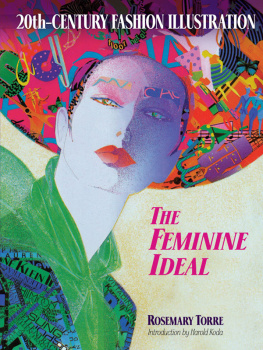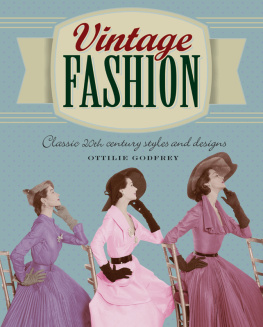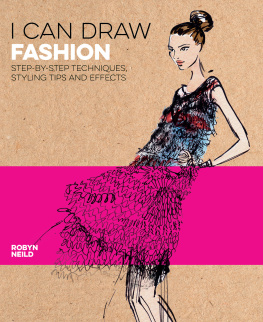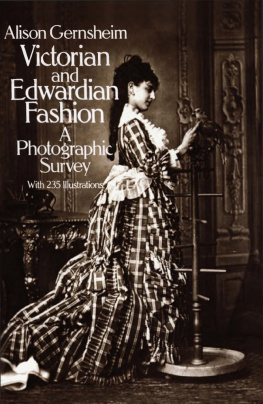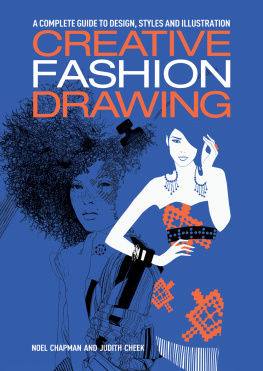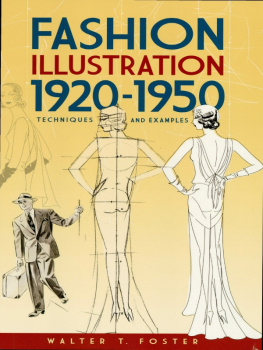THE
Vintage Fashion
ILLUSTRATION MANUAL
EDITH YOUNG

DOVER PUBLICATIONS, INC.
MINEOLA, NEW YORK
Bibliographical Note
This Dover edition, first published in 2018, is an unabridged republication of the work originally published as Students Manual of Fashion Drawing: Thirty Lessons with Conventional Charts by John Wiley and Sons, Inc., New York, in 1919.
Library of Congress Cataloging-in-Publication Data
Names: Young, Edith, author.
Title: The vintage fashion illustration manual / Edith Young.
Other titles: Students manual of fashion drawing
Description: Mineola, New York : Dover Publications, Inc., 2018. | This Dover edition, first published in 2018, is an unabridged republication of the work originally published as Students Manual of Fashion Drawing: Thirty Lessons with Conventional Charts by John Wiley and Sons, Inc., New York, in 1919.
Identifiers: LCCN 2017052335| ISBN 9780486824543 (paperback) | ISBN 0486824543
Subjects: LCSH: Fashion drawingTechnique. | BISAC: DESIGN / Fashion. | DESIGN / Textile & Costume. | CRAFTS & HOBBIES / Fashion.
Classification: LCC TT509 .Y6 2018 | DDC 746.9/2dc23
LC record available at https://lccn.loc.gov/2017052335
Manufactured in the United States by LSC Communications
824543012018
www.doverpublications.com
CONTENTS
INTRODUCTION
Many young people, who have a desire to draw, are much interested in fashion drawing and wish to take up the subject without any preparatory instruction in art. They thus bring to the study practically no knowledge of fashions and very little knowledge of drawing. Successful instruction for such classes must necessarily follow a very definite and carefully worked-out plan. The first steps must be very simple, and the succeeding steps must follow in a carefully selected order and in easy stages, with numerous illustrations and ample opportunity for drill on fundamentals.
The author of this manual has had much experience in teaching pupils of the limited preparation suggested, in connection with her classes in fashion drawing at the Young Womens Christian Association and the Albert Business College, Newark, N. J. The text sets forth in detail the course of instruction which has been followed with these classes and which has been found to give the quickest and best results. Fundamental principles are carefully explained, but the authors aim has been not so much to offer a discussion of methods in fashion drawing as to provide the means for practice in applying these methods. The pupil will learn best by carefully following directions and by constant practice. The manual is to be used as a guide.
In this connection it should perhaps be stated that the plates given in connection with the lessons are not supposed to be artistic or pretty. They are conventional charts illustrating the subject. As such they are very set, because in this way the meaning can be made clear with few lines. Merely copying these charts will not make the pupil a fashion artist. They are illustrations intended rather to teach the pupil how to study. Every chart is fully explained, and as each illustration is important, it must be mastered as it is encountered. Any part skipped will cause trouble later on. After the student has drawn all figures understandingly, in a conventional manner, he should make original drawings, using these principles and pictures as guides, but putting feeling and grace into his work.
After studying each lesson carefully until it is fully understood and making drawings for the same, study the fashion papers and find the subjects that you have learned. In this, select only pen and ink illustrations, as they are line drawings and are clear cut; photos and wash drawings are too vague for the beginner.
In the fashion field, the artist may use a picture as a model and from it construct an original figure which may be dressed in any costume.
Make a collection of pictures. Save all fashion papers, newspaper clippings, advertisements, cards, etc. Place these in boxes, keeping them sorted; that is, figures in underclothes and the nude in one box, newspaper clippings in another, decorative work, such as dealt with in , in another, etc. Begin right now to save, then when you get to the lessons on the back and on sitting figures, you will have something to work from. The cry has been so often, I can not find any back figure in underclothes. Do not let this happen to you.
In drawing, the pupil is urged to heed the following suggestions: When beginning to draw, use a blunt pencil point with plenty of lead exposed, at least one-third inch. For fine work, such as faces, hands, details, etc., use a very fine point. I cannot be too emphatic about this. So many drawings are poor for the simple reason that a dull point is not the proper tool for fine lines. To save time, sharpen your pencil often on an emery pad.
For the main part of costumes, a fine point is not good; have plenty of lead exposed and do not try to draw with the wood.
When you use an eraser, build as you rub. Erase the old lines often, allowing them to show, and on these indistinct lines make your drawing better. Use a soft rag or feather duster to clean off the specks. After drawing for a time, rest the eye, as the eye becomes stale with close watching. View your picture at a distance, reverse it in a looking-glass, turn it upside down. A diminishing glass helps in detecting errors.
Learn to criticise your own work, and let others criticise it for you, even if they are not artists. A novice will often see a defect that you have passed over. Be on the lookout for anything that will help you in your study, be it a picture, a book, or gowns themselves.
Learn to trust to your eye, but if you are not satisfied with results, use the following measuring system to true up your work: On a piece of cardboard, one inch by four or five inches, mark off at the top a measurement of the model, say one-half head. Below this mark make another mark the size of one-half the head of your figure. See how many times the first measurement goes into certain parts on the model. Use the second measurement on all corresponding parts on your drawing.
EDITH YOUNG.
NEWARK, N. J., 1919.
DRAWING MATERIALS
For Pencil Work. Drawing board (or baking board); drawing tablet; medium soft pencil (H. B.); soft eraser; thumbtacks; emery sharpener; penknife; soft cotton rag; portfolio; pencil holder; note book.
For Ink Work. Bristol board (plate finish) or pen and ink paper; hard pencil eraser; ink eraser (be careful of its use); two pen holders; two No. 170 Gillott pens; two No. 290 Gillott pens; one stub-pen; bottle Higgins drawing ink (waterproof); small camels hair brush (for ink); one sheet of tracing paper; one sheet of blotting paper.
For Water-color Work. Illustration board; sable hair brushes (No. 2 and No. 6); water colors in one-half pans as follows: Yellow ochre, gamboge, (x) indian yellow, (x) rose madder, madder brown, (x) light red, crimson lake, vermilion, orange vermilion, Paynes gray, Vandyke brown, burnt sienna, raw sienna, burnt umber, raw umber, (x) sepia, (x) Hunters green, (x) Hookers green (No. 1 and No. 2), ultramarine blue, cobalt, Prussian blue; tin box to hold more than these colors; lamp black (in a tube); Devoes show card white (in a jar); Semples white (in a jar).
There are many more good colors. The colors marked (x) may be omitted for the present. Greens can be mixed.
Useful Articles. Magnifying glass; diminishing glass; T-square; ruler with metal edge; ruling pen; compass; ink compass; art gum (to clean drawings); fixatif (to spray charcoal and pencil drawings); atomizer; small piece of blue glass (to study drawings through); kneaded eraser (for pencil or charcoal work); plumb line; raw potato (to clean pens); crayon pencils, No. 1, 2, 3, B.




